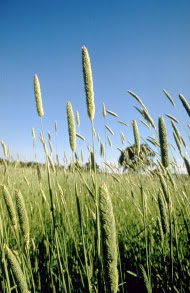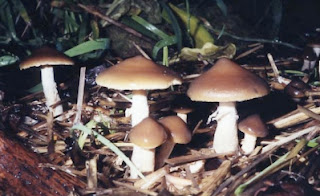First off, apologies in advance for the exclusive focus on the United States in this post. I realize that many of you aren't from the US of A. Heck, I'm not. But I found a cool article on PubMed and I thought you people might find it interesting. So I've summarized it for y'all. Don't know about you, but I have a tendency to associate drug-containing plants and fungi with exotic locales. Anticancer drugs from the Amazon Rainforest. Opium from Afghanistan. Cocaine from Columbia. That sort of thing. So when I came across an article on drugs, psychedelic drugs no less, found in plants and fungi that have established themselves in American soil, I was intrigued. Please note that I will be discussing species that are growing wild, not those being cultivated in greenhouses and suburban basements.

The short-acting hallucinogen DMT, most often associated with the Amazonian brew ayahuasca, is also present in appreciable quantities in several common species of grass belonging to the genus Phalaris, including P. aquatica (bulbous canarygrass, Harding Grass), P. arundinacea (reed canary grass), and P. brachystachys (shortspike canarygrass). These grasses can be found hanging out in the fields, sidewalk cracks, abandoned parking lots, and poorly-maintained lawns of Middle America. DMT is also found in the root bark of Desmanthus illinoensis (prairie bundleflower), which is also found throughout the Land of Liberty.

Psilocybin is one of several related hallucinogens found in a number of mushrooms belonging to a number of genera, including Gymnopilus, Panaeolus, and Psilocybe. While these 'magic mushrooms' are historically associated with Mexico, where they used religiously by the native peoples of Mesoamerica, many species are found growing on cow and horse poop in the USA. That's right folks, many shrooms are coprophagous (they grow on and consume feces). So the next time you eat some, try not to think about that. Bad trip. As far as localization goes, they are generally found along the coastlines of the Gulf of Mexico (Florida to Texas) and Pacific Northwest (including California).

In the desert along the Texas-Mexico border, you can find Lophophora williamsii (peyote). This spineless cactus is the natural source of mescaline, a hallucinogen enjoyed by luminaries such as Aldous Huxley and Eli Cash.

Lysergic acid amide (LSA), a natural analogue of LSD, is found in the seeds of of Argyreia nervosa (Hawaiian baby woodrose) and several members of the genus Ipomoea (morning glory). The woodrose is found only in Hawaii, having been introduced from Asia, while morning glory plants are found across the US. LSA is also present in Achnatherum robustum (aka Stipa robusta or Sleepy grass), which is found in the American southwest.

In addition to the classic hallucinogens, there are a number of drugs capable of producing a toxic delirium that features hallucinations. These so-called dissociative agents are generally much more dangerous than the hallucinogens. Atropine and scopolamine, anticholinergic dissociative agents, are found in a number of plants belonging to the Solanaceae family that grow wild in the States. These include Datura stamonium (Jimson weed), Atropa belladonna (deadly nightshade), and Mandragora officinarum (mandrake), and Hyoscyamus niger (henbane). Of these, only plants of the genus Datura are native to the United States, the rest having being introduced due to their pretty flowers or something. Mushrooms of the genus Amanita, found throughout Canada's southern neighbour (ha, eat my Canadian spelling, suckas!), contain the dissociative agents ibotenic acid, muscimol, and muscazone. Unfortunately, some species also contain fun toxins like α-amanitin, which can cause lethal liver and kidney damage. These ones usually have scary names like death cap and destroying angel. Arguable the best known Amanita mushroom is Amanita muscaria, which looks pretty darn cool.
Halpern JH. Hallucinogens and dissociative agents naturally growing in the United States. Pharmacol Ther. 2004 May;102(2):131-8.







